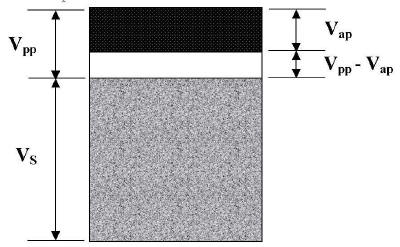Basic aggregate weight-volume relationships are important to understand aggregate structure and properties. Fundamentally, aggregate volume properties are desired, but since mass measurements are typically much easier, masses are typically taken then converted to volume by using specific gravities. The following is a brief discussion of the more important mass-volume relationships of aggregates.

| Gsa | equals | Apparent specific gravity of the aggregate | Ws | equals | Oven-dry weight of aggregate | |
| Gb | equals | Asphalt binder specific gravity | VS | equals | volume of the solids | |
| Gsb | equals | Bulk specific gravity of the aggregate | Vpp | equals | volume of water permeable pores | |
| Gse | equals | Effective specific gravity of the aggregate | Vap | equals | volume of pores absorbing asphalt | |
| Gmb | equals | Bulk specific gravity of the compacted mixture | Pb | equals | Asphalt content by weight of mix (percent) | |
| Gmm | equals | Maximum theoretical specific gravity of the HMA mixture | Ps | equals | Aggregate content by weight of mix (percent) | |
| G1 | equals | Coarse aggregate specific gravity (retained on the 4.75 mm (No. 4) sieve) | P1 | equals | Coarse aggregate fraction (retained on the 4.75 mm (No. 4) sieve) | |
| G2 | equals | Fine aggregate specific gravity (between the 4.75 mm (No. 4) and 0.075 mm (No. 200) sieve) | P2 | equals | Fine aggregate fraction (between the 4.75 mm (No. 4) and 0.075 mm (No. 200) sieve) | |
| G3 | equals | Mineral filler specific gravity (passing the 0.075 mm (No. 200) sieve) | P3 | equals | Mineral filler fraction (passing the 0.075 mm (No. 200) sieve) | |
| γW | equals | Unit weight of water | Vpp – Vap | equals | volume of water permeable pores not absorbing asphalt |
Specific Gravities
Apparent Specific Gravity (Gsa)
Includes only the volume of the aggregate particle. It does not include the void volume that becomes filled with water during the test soak period. Ideally, it would not include any void volume but in reality some voids may not become entirely filled with water during the test soak period. The void volume that does not become filled with water is thus counted with the solid volume. Since it is intended to only measure the specific gravity of the solid volume, it will be the highest of the three aggregate specific gravities.
Standard apparent specific gravity tests are:
- AASHTO T 84 and ASTM C 127: Specific Gravity and Absorption of Fine Aggregate
- AASHTO T 85 and ASTM C 128: Specific Gravity and Absorption of Coarse Aggregate
Bulk Specific Gravity (Gsb or BSG)
Includes the volume of the aggregate particle plus the void volume that becomes filled with water during the test soak period. Since it includes the void volume, bulk specific gravity will be less than apparent specific gravity. It is very important to measure Gsb as accurately as possible. Since it is used to convert weight measurements to volumes, any small errors in Gsb will be reflected in significant volume errors, which may go undetected.
Standard bulk specific gravity tests are:
- AASHTO T 84 and ASTM C 127: Specific Gravity and Absorption of Fine Aggregate
- AASHTO T 85 and ASTM C 128: Specific Gravity and Absorption of Coarse Aggregate
Effective Specific Gravity (Gse)
Typically used with HMA. The ratio of the mass in air of a unit volume of a permeable material (excluding voids permeable to asphalt) at a stated temperature to the mass in air (of equal density) of an equal volume of gas-free distilled water at a stated temperature. Gse includes the volume of the aggregate particle plus the void volume that becomes filled with water during the test soak period minus the volume of the voids that absorb asphalt. Effective specific gravity lies between apparent and bulk specific gravity.
The standard effective specific gravity calculation is contained in:
- AASHTO PP 19: Standard Practice for Volumetric Analysis of Compacted Hot-Mix Asphalt (HMA)
